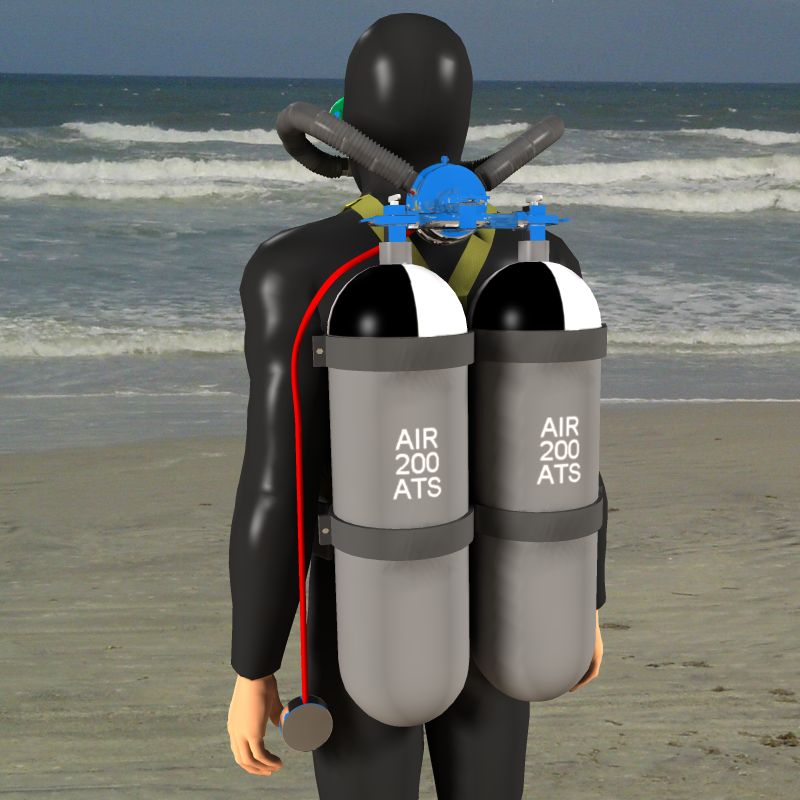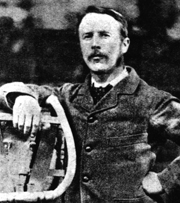|
Émile Gagnan
Émile Gagnan (1900 – 1984) was a French engineer and, in 1943, co-inventor with French Navy diver Jacques-Yves Cousteau of the Aqua-Lung, the diving regulator (a.k.a. demand-valve) used for the first Scuba equipment. The demand-valve, or regulator, was designed for regulating gas in gas-generator engines, but was found to be excellent for regulating air-supply under varied pressure conditions. This allowed people to explore the ocean more easily, even though the original purpose was different. Gagnan was born in the French province of Burgundy in November 1900, and graduated from technical school in the early 1920s. He was employed as an engineer specializing in high-pressure pneumatic design by the large gas-supply firm Air Liquide. The first production 'Scaphandre Autonome' - or 'Aqualung' was released in France in 1946 under the identification code "CG45" ("C" for Cousteau, "G" for Gagnan and "45" for 1945, year of the patent). A year later, in 1947, Émile Gagnan and h ... [...More Info...] [...Related Items...] OR: [Wikipedia] [Google] [Baidu] |
Engineer
Engineers, as practitioners of engineering, are professionals who invent, design, analyze, build and test machines, complex systems, structures, gadgets and materials to fulfill functional objectives and requirements while considering the limitations imposed by practicality, regulation, safety and cost. "Science is knowledge based on our observed facts and tested truths arranged in an orderly system that can be validated and communicated to other people. Engineering is the creative application of scientific principles used to plan, build, direct, guide, manage, or work on systems to maintain and improve our daily lives." The word ''engineer'' (Latin ) is derived from the Latin words ("to contrive, devise") and ("cleverness"). The foundational qualifications of an engineer typically include a four-year bachelor's degree in an engineering discipline, or in some jurisdictions, a master's degree in an engineering discipline plus four to six years of peer-reviewed professiona ... [...More Info...] [...Related Items...] OR: [Wikipedia] [Google] [Baidu] |
Jacques-Yves Cousteau
Jacques-Yves Cousteau, (, also , ; 11 June 191025 June 1997) was a French naval officer, oceanographer, filmmaker and author. He co-invented the first successful Aqua-Lung, open-circuit SCUBA (self-contained underwater breathing apparatus). The apparatus assisted him in producing some of the first underwater documentaries. Cousteau wrote many books describing his undersea explorations. In his first book, ''The Silent World: A Story of Undersea Discovery and Adventure'', Cousteau surmised the existence of the Animal echolocation, echolocation abilities of porpoises. The book was adapted into an underwater documentary called ''The Silent World''. Co-directed by Cousteau and Louis Malle, it was one of the first films to use underwater photography, underwater cinematography to document the ocean depths color photography, in color. The film won the 1956 Palme d'Or at the Cannes Film Festival and remained the only documentary to do so until 2004, when ''Fahrenheit 9/11'' received the ... [...More Info...] [...Related Items...] OR: [Wikipedia] [Google] [Baidu] |
Aqua-Lung
Aqua-Lung was the first open-circuit, self-contained underwater breathing apparatus (or "scuba") to achieve worldwide popularity and commercial success. This class of equipment is now commonly referred to as a twin-hose diving regulator, or demand valve. The Aqua-Lung was invented in France during the winter of 1942–1943 by two Frenchmen: the engineer Émile Gagnan and the Naval Lieutenant (French: "lieutenant de vaisseau") Jacques Cousteau. It allowed Cousteau and Gagnan to film and explore underwater more easily. The invention revolutionised autonomous underwater diving by providing a compact, reliable system capable of a greater depth range and endurance than its precursors, and was a major factor influencing the development of recreational scuba diving after WWII. The twin-hose Aqua-Lung demand regulator is the foundation of all modern scuba regulators. A diaphragm is used to control a valve to deliver the breathing gas to the diver on demand, at ambient water pressure. Ho ... [...More Info...] [...Related Items...] OR: [Wikipedia] [Google] [Baidu] |
Diving Regulator
A diving regulator is a pressure regulator that controls the pressure of breathing gas for diving. The most commonly recognised application is to reduce pressurized breathing gas to ambient pressure and deliver it to the diver, but there are also other types of gas pressure regulator used for diving applications. The gas may be air or one of a variety of specially blended breathing gases. The gas may be supplied from a scuba cylinder carried by the diver or via a hose from a compressor or high-pressure storage cylinders at the surface in surface-supplied diving. A gas pressure regulator has one or more valves in series which reduce pressure from the source, and use the downstream pressure as feedback to control the delivered pressure, or the upstream pressure as feedback to prevent excessive flow rates, lowering the pressure at each stage. The terms "regulator" and "demand valve" are often used interchangeably, but a demand valve is the final stage pressure-reduction regulator ... [...More Info...] [...Related Items...] OR: [Wikipedia] [Google] [Baidu] |
Scuba Set
A scuba set, originally just scuba, is any breathing apparatus that is entirely carried by an underwater diver and provides the diver with breathing gas at the ambient pressure. ''Scuba'' is an anacronym for self-contained underwater breathing apparatus. Although strictly speaking the scuba set is only the diving equipment that is required for providing breathing gas to the diver, general usage includes the harness by which it is carried, and those accessories which are integral parts of the harness and breathing apparatus assembly, such as a jacket or wing style buoyancy compensator and instruments mounted in a combined housing with the pressure gauge, and in the looser sense, it has been used to refer to all the diving equipment used by the scuba diver, though this would more commonly and accurately be termed scuba equipment or scuba gear. Scuba is overwhelmingly the most common underwater breathing system used by recreational divers and is also used in professional diving whe ... [...More Info...] [...Related Items...] OR: [Wikipedia] [Google] [Baidu] |
Burgundy (region)
Burgundy (; french: link=no, Bourgogne ) is a historical territory and former Regions of France, administrative region and province of east-central France. The province was once home to the Duke of Burgundy, Dukes of Burgundy from the early 11th until the late 15th century. The capital of Dijon was one of the great European centres of art and science, a place of tremendous wealth and power, and Western Monasticism. In early Modern Europe, Burgundy was a focal point of courtly culture that set the fashion for European royal houses and their court. The Duchy of Burgundy was a key in the transformation of the Middle Ages toward early modern Europe. Upon the 9th-century partitions of the Kingdom of Burgundy, the lands and remnants partitioned to the Kingdom of France were reduced to a ducal rank by King Robert II of France in 1004. The House of Burgundy, a cadet branch of the House of Capet, ruled over a territory that roughly conformed to the borders and territories of the modern ... [...More Info...] [...Related Items...] OR: [Wikipedia] [Google] [Baidu] |
Air Liquide
Air Liquide S.A. (; ; literally "liquid air"), is a French multinational company which supplies industrial gases and services to various industries including medical, chemical and electronic manufacturers. Founded in 1902, after Linde it is the second largest supplier of industrial gases by revenues and has operations in over 80 countries. It has headquarters at the 7th arrondissement of Paris. Air Liquide owned the patent for Aqua-Lung until it expired. Air Liquide's headquarters are in Paris, and it also has major sites in Japan, Houston, Newark, Delaware, Frankfurt, Shanghai and Dubai. The company's research and development ( R&D) targets the creation of industrial gases, and also gases that are used in products such as healthcare items, electronic chips, foods, and chemicals. The major R&D groups within Air Liquide focus on analysis, bioresources (foods and chemicals), combustion, membranes, modeling, and the production of hydrogen (H2) gas. History 1900 - 1930: Creat ... [...More Info...] [...Related Items...] OR: [Wikipedia] [Google] [Baidu] |
Montreal
Montreal ( ; officially Montréal, ) is the List of the largest municipalities in Canada by population, second-most populous city in Canada and List of towns in Quebec, most populous city in the Provinces and territories of Canada, Canadian province of Quebec. Founded in 1642 as ''Fort Ville-Marie, Ville-Marie'', or "City of Mary", it is named after Mount Royal, the triple-peaked hill around which the early city of Ville-Marie is built. The city is centred on the Island of Montreal, which obtained its name from the same origin as the city, and a few much smaller peripheral islands, the largest of which is Île Bizard. The city is east of the national capital Ottawa, and southwest of the provincial capital, Quebec City. As of 2021, the city had a population of 1,762,949, and a Census Metropolitan Area#Census metropolitan areas, metropolitan population of 4,291,732, making it the List of the largest municipalities in Canada by population, second-largest city, and List of cen ... [...More Info...] [...Related Items...] OR: [Wikipedia] [Google] [Baidu] |
Quebec
Quebec ( ; )According to the Canadian government, ''Québec'' (with the acute accent) is the official name in Canadian French and ''Quebec'' (without the accent) is the province's official name in Canadian English is one of the thirteen provinces and territories of Canada. It is the largest province by area and the second-largest by population. Much of the population lives in urban areas along the St. Lawrence River, between the most populous city, Montreal, and the provincial capital, Quebec City. Quebec is the home of the Québécois nation. Located in Central Canada, the province shares land borders with Ontario to the west, Newfoundland and Labrador to the northeast, New Brunswick to the southeast, and a coastal border with Nunavut; in the south it borders Maine, New Hampshire, Vermont, and New York in the United States. Between 1534 and 1763, Quebec was called ''Canada'' and was the most developed colony in New France. Following the Seven Years' War, Quebec b ... [...More Info...] [...Related Items...] OR: [Wikipedia] [Google] [Baidu] |







